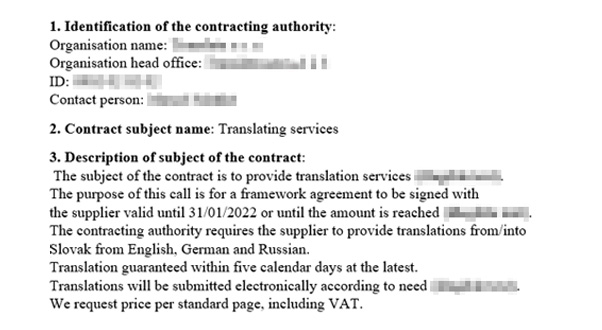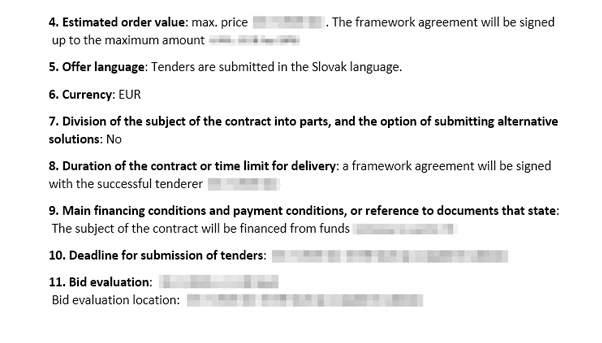A cornerstone for selecting an effective supplier is being as accurate as possible when describing your needs. Without knowing the requirements, it’s difficult for a translation agency to put together a price offer.
We’ll use a real tender as an example , in which we’ll demonstrate what a tender shouldn’t look like and how we can make it more efficient.
 1. We don’t know the nature of the documents that are to be translated
1. We don’t know the nature of the documents that are to be translated
Although this is one of the basic pieces of information that a translation agency needs to know, it’s missing from the tender. The complexity and price of a translation depend on the nature of the documents. Professional translations (e.g. legal documents, technical manuals, economic analyses) contain common terminology and require translators with specialisation in the given field to ensure top-quality results. On the other hand, translations of a general nature are not strict in terms of technical terminology and are therefore easier to translate.
How to do it better: Be specific about the content of the documents. This will help the agency determine the complexity of the translation. Here’s an example: “The documents we need to translate include 3 contracts for the purchase of computer equipment, an annual report for 2019, and documents related to our participation in approx. 8 foreign tenders.”
2. We don’t know what purpose the texts will be used for
Specifying the purpose of a text will allow translators and proofreaders to adapt the translation to the target audience. Companies set different requirements on internal communications (e.g. newsletters, intranets) than on external company communications (e.g. on a website). It’s common practice to develop brand manuals that determine the framework of internal and external communications, and ideally the translator and proofreader must know about them.
How to do it better: Define where the translated texts will be published and who will read them. Here’s an example: “Contracts will be stored in an internal archive, the annual report will be addressed to the Supervisory Board and will be published on our company website. Tender documents will be assessed by an expert committee.”
3. The document format isn’t specified
The invitation to tender fails to state what format the client’s documents they need translating are in. As a result, this runs the risk of price increases if the agency finds in the source texts non-editable file types (such as scans). Modern translation tools can read a variety of non-standard formats (even programming code), but uneditable files must be converted before they can be translated. It’s more time-consuming and will be reflected in the final price.
How to do it better: Indicate what document formats are available to you and try to estimate the percentage of non-editable files. Here’s an example: “The documents are in PDF, Word, and Excel formats. The annual report contains 17 graphs in .jpg/.jpeg format.”
 4. The expected scope and word count for the project is missing
4. The expected scope and word count for the project is missing
The client requires guaranteed delivery of the translations in 5 days but fails to specify the word count or the number of pages of texts that they need to translate. Although we work with more than 6,000 translators and have dealt with various tight deadlines in the past, it can still be difficult to guarantee the delivery of a quality translation when we don’t know how much text we need to translate.
One-off, large-scale projects require the commitment of a team of several translators and proofreaders at the same time. On the flip side, long-term, regular translations of smaller volumes allow agencies to plan translators’ workloads in advance.
How to do it better: Try to estimate the volume of texts you’ll need translating (for example, standard pages or word count), or give an approximation of the volume based on past projects. Here’s an example: “Contracts for the purchase of equipment are 9 pages long each and we need to archive them within 6 weeks. The annual report is 42 pages long, the deadline for publication is the end of June of this year, and the documents for foreign tenders usually range from 70 to 110 pages long. Tenders are published throughout the year. Last year we participated in 8 tenders, two in each quarter. We currently have 2 in progress, which we need to send in about a month and then the remaining tenders depending on how they open up over the course of the year.”

5. Establishing objective criteria for the evaluation of tenders
In one example of a bid for tender, the lowest price is set as the only evaluation criterion for tender participants. Differences in price vary tremendously in the translation market. So at first glance, a low price might seem to be the most important parameter for concluding a cooperation contract with a supplier.
A translation agency’s pricing is influenced by a number of factors ranging from experienced staff, quality certificates, and the technology used to cost-saving automation and any additional services the agency can provide.
Cheap translations aren’t always good and good translations aren’t always cheap. Inaccuracies can result in embarrassing or unpleasant situations and the costs to fix them can far exceed the amount you saved in the first place.
How to do it better: Set evaluation criteria for the tender in a way that allows you to test the professional competence of the vendors and the technology they use. Don’t be afraid to request a free trial translation and service testimonials.